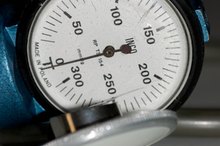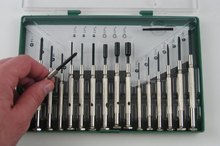What does fact checked mean?
At Healthfully, we strive to deliver objective content that is accurate and up-to-date. Our team periodically reviews articles in order to ensure content quality. The sources cited below consist of evidence from peer-reviewed journals, prominent medical organizations, academic associations, and government data.
The information contained on this site is for informational purposes only, and should not be used as a substitute for the advice of a professional health care provider. Please check with the appropriate physician regarding health questions and concerns. Although we strive to deliver accurate and up-to-date information, no guarantee to that effect is made.
How to Write an ABG
Doctors use an arterial blood gas (ABG) test to determine a patient’s ability to take in oxygen and expel carbon dioxide 1. The ABG test results indicate the pH, partial pressure of carbon dioxide and the bicarbonate content of the blood sample. Rather than write a long sentence describing the calculated measurements of each component or provide a vertical list of each measurement, technicians and doctors use an abbreviated method for stating all components as a single expression.
Write the calculated pH level to the nearest one-hundredth. For example, a normal blood pH would be 7.39.
How to Set Up the Flow Meter on a Oxygen Concentrator
Learn More
Place a “/” behind the pH value. Continuing from the above example, the ABG now reads 7.39/.
Write the calculated partial pressure of carbon dioxide (PaCO2) expressed as a whole number. The ABG now reads “7.39/42.”
How to Read the SYS DIA Pulse
Learn More
Place a “/” behind the PaCO2. The ABG now reads “7.39/42/.”
Write the calculated partial pressure of oxygen (PaO2). The ABG now reads “7.39/42/80.”
Place a “/” behind the PaO2. The ABG now reads “7.39/42/80/.”
Write the calculated bicarbonate level. The ABG now read “7.39/42/80/24,” and is complete.
Tips
Translate the above written ABG as, “The pH of the blood is 7.39, containing a partial carbon dioxide pressure of 42 mmHg, a partial oxygen pressure of 80 mmHg, and a bicarbonate level of 24 mEq/L.”
Related Articles
References
- University of Washington;A Primer on Arterial Blood Gas Analysis; Andrew M. Luks, MD
- Medline Plus; Blood Gases; May 2011
- Castro D, Keenaghan M. Arterial Blood Gas. InStatPearls [Internet]. StatPearls Publishing. Updated February 1, 2019.
- Abdo WF, Heunks LM. Oxygen-induced hypercapnia in COPD: myths and facts. Crit Care. 2012;16(5):323. doi:10.1186/cc11475
- Cukic V. The changes of arterial blood gases in COPD during four-year period. Med Arch. 2014;68(1):14–18. doi:10.5455/medarh.2014.68.14-18
- Sood P, Paul G, Puri S. Interpretation of arterial blood gas. Indian J Crit Care Med. 2010;14(2):57–64. doi:10.4103/0972-5229.68215
Tips
- Translate the above written ABG as, "The pH of the blood is 7.39, containing a partial carbon dioxide pressure of 42 mmHg, a partial oxygen pressure of 80 mmHg, and a bicarbonate level of 24 mEq/L."
Writer Bio
Transplanted Yankee Erin Watson-Price lives in Birmingham, Ala., and has been writing freelance articles since 1997. She worked as writer/co-editor for Coast to Coast Dachshund Rescue's newsletter, "The Long and the Short of It." In 2007 she obtained a certification as a copy editor. Watson-Price holds a Bachelor of Arts in creative writing from Southern Illinois University-Edwardsville.








